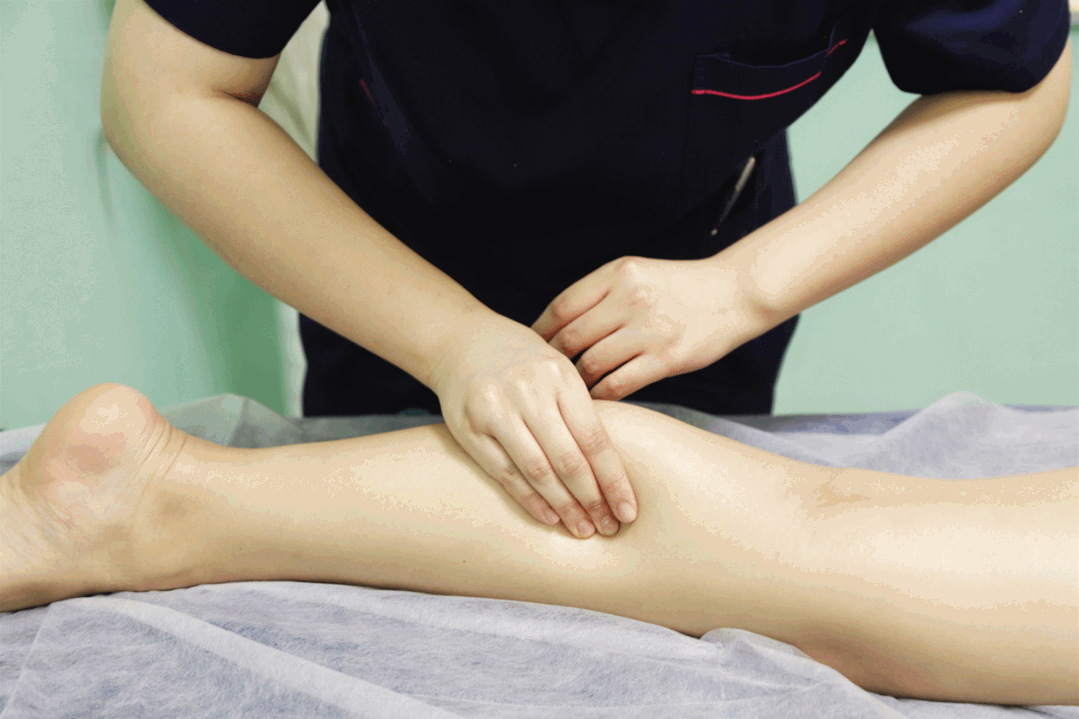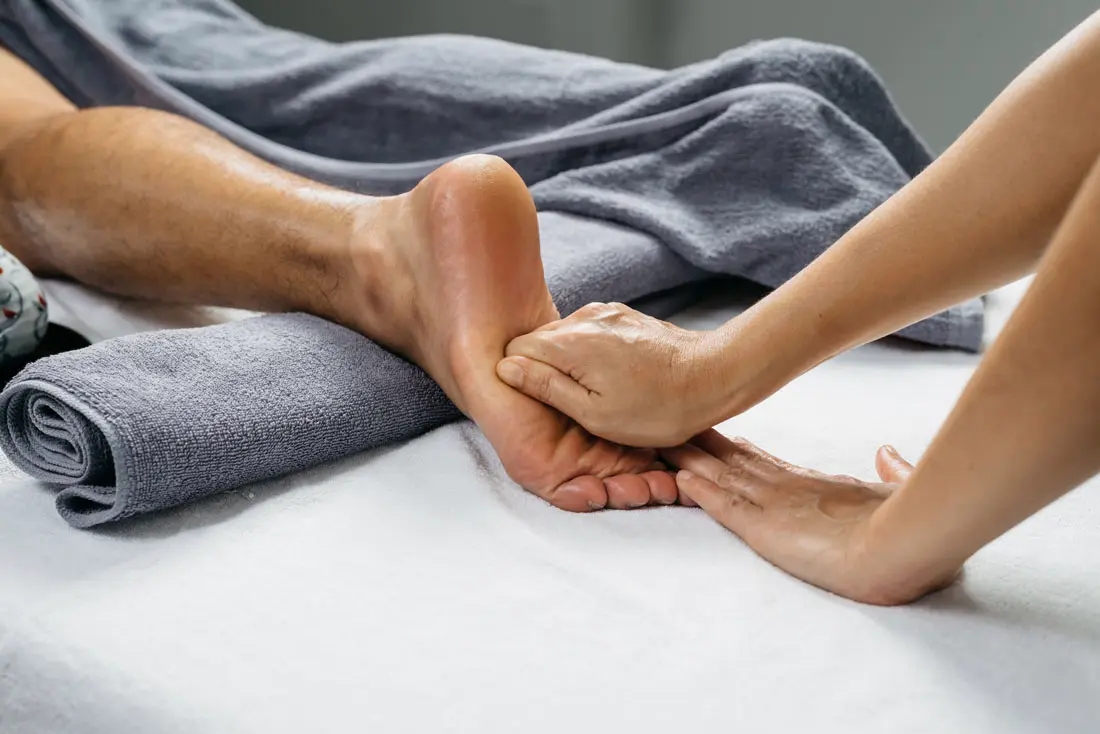Why Massage Say That Deep Tissue Massage Helps Plantar Fasciitis
Since shortening of the plantar flexor muscles could increase stress on the plantar fascia, it seems reasonable that massage to these muscles would relieve foot pain in patients with PHPS. However, until recently, there was no scientific evidence that deep tissue massage of the calf muscles reduces PHPS symptoms. The Massage Therapy Foundation’s research column is summarizing a recent single-blind randomized clinical trial on the effects of deep massage combined with neural mobilization exercises. The article is titled “Deep massage to posterior calf muscles in combination with neural mobilization exercises as a treatment for heel pain: A pilot randomized clinical trial” and was published online in the journal Manual Therapy in September 2013.
Can ten minutes of deep tissue massage combined with stretching alleviate plantar fasciitis? Plantar fasciitis, also known as plantar heel pain syndrome (PHPS), is a common pathology characterized by pain on the sole of the foot. Often, the pain is worse in the morning and when coming up on the toes of the affected foot. Both the plantar fascia and plantar flexor muscles are often tender to palpation and may contain myofascial trigger points. Unfortunately, there is limited evidence for what clinical treatment is effective for PHPS. More and more, massage therapy and stretching are seen as first-line interventions, in contrast to steroid injections or possible surgery.
The authors, based at an outpatient physical therapy clinic in Israel, recruited consecutive patients with PHPS who were referred by an orthopedic surgeon. PHPS was defined as plantar heel pain that was worse with initial weight bearing after a period of rest but improved with activity. Patients were excluded if they had systemic disease, tumor, fracture, a history of corticosteroid use, severe vascular disease, prior lower leg surgery, referred pain to the heel from a source other than the posterior calf muscles, or an inability to attend scheduled treatments. The study was single-blind in that one author, who did not provide treatment and did not randomize patients, conducted the physical examinations at admission and discharge.

Sixty-nine patients were randomized into either the massage group (n = 36) or the ultrasound group (n = 33). There were no significant differences between the two groups of patients at baseline. All patients received eight treatments over a 6-week period with a frequency of 1 to 2 sessions per week. Treatment was performed by one of fifteen staff physical therapists. It was noted that only 51 participants completed the treatments and discharge assessment. Additionally, there were no significant differences between those who dropped out of the massage group and those who dropped out of the ultrasound group.
The massage therapy intervention was performed with the patients lying prone with their feet off the end of the table. Ten minutes of deep massage therapy was performed using “forceful soft tissue massage mobilization techniques, described by Cyriax (1984), directed to the incompliant and painful areas of the posterior calf muscle group.” The therapists massaged the medial and lateral aspects of the posterior calf from both a medial and lateral approach. The pressure was deep enough to generate a pain response and was performed with thumbs or another body part, such as an elbow.
The massage intervention was compared to a treatment of ultrasound. The authors report that although ultrasound has not been shown to be effective for PHPS, it is still commonly used in some physical therapy clinics. Ultrasound was delivered to the painful area on the heel using slow circular movements for three minutes at a frequency of 1 MHz and intensity of 1.0 W/cm. The ultrasound group did not receive the neural mobilization exercise.
Calf muscle stretching has been shown at both short- and long-term follow-up to be effective in managing PHPS. Thus, all patients in the study were instructed in self-stretching directed at the posterior calf muscles. A standing calf stretch was taught, with the affected foot furthest from the wall and both feet positioned in a line. The patient leaned forward while keeping the heels on the floor until a stretch was felt in the posterior calf or achilles. In order to stretch the gastrocnemius, the back knee was kept extended, and, in order to stretch the soleus, the back knee was bent. Each of these stretches was performed three times daily, 5 repetitions of 20s stretching with 10s rest.
In addition to the calf stretches, the group of patients randomized to receive deep massage also performed a neural mobilization exercise. Patients performed a passive straight leg raise with dorsiflexion using a long belt. The idea was that doing so would increase tension on neural structures such as the plantar nerve and further alleviate pain. The authors do not state the duration or frequency of this neural mobilization exercise, though it may have been performed like the stretches.
In order to assess response, the authors used the Foot & Ankle Computerized Adaptive Test (CAT), which is a patient-rated functional outcome measure based on the Lower Extremity Functional Scale (LEFS). The Foot & Ankle CAT is rated from 0 (low functioning) to 100 (high functioning). Pain on taking first steps in the morning was rated on a 10-cm visual analogue scale (VAS).
The authors performed a mixed-model ANOVA, which showed a significant group-by-time effect (p = 0.034) for change in the Foot & Ankle CAT in both groups. This change was still significant (p = 0.025) after the authors controlled for age, gender, body mass index (BMI), and chronicity. The massage group improved on the Foot and Ankle CAT from an average of 47% at baseline to an average of 62% after treatment. The 95% confidence interval for improvement in the massage group was 9% to 21%. The ultrasound group improved on the Foot and Ankle CAT from an average of 50% at baseline to an average of 56% after treatment. The 95% confidence interval for improvement in the ultrasound group was 1% to 11%. The group-by-time interaction from the ANOVA indicated a significant (p = 0.034) difference in improvement between the two groups.
The pain level with first morning steps of patients in both groups also decreased significantly for all participants. However, there was not a significant difference in pain levels between the groups. The massage group reported a reduction in morning pain levels from an average of 6.8 out of 10 at baseline to an average of 4.2 out of 10 after treatment. The 95% confidence interval for pain improvement in the massage group was -1.4 to -3.4. The ultrasound group reported a reduction in morning pain levels from an average of 6.9 out of 10 at baseline to an average of 4.4 out of 10 after treatment. The 95% confidence interval for pain improvement in the ultrasound group was -1.4 to -3.8.

The authors concluded that the change in functional status of the patients in the massage group was both statistically and clinically significant. They stated that the change in functional status of the patients in the ultrasound group was not clinically significant despite being statistically significant. Both groups experienced a clinically relevant improvement in pain with first steps in the morning.
The study has limitations that affect its applicability to everyday massage practice. The study included a small sample size with many patients who dropped out. There was no true control group, as patients in the ultrasound group received a treatment of ultrasound as well as the calf stretches. Finally, since only the massage group received the neural mobilization exercise, the use of this exercise confounds the effect of deep massage.
In conclusion, deep massage of the posterior calf combined with stretching may improve the function of patients with plantar fasciitis more than a combination of ultrasound and stretching. Ten minutes of deep pressure massage to the posterior calf easily fits into most therapeutic massage sessions and may be worth a try with your clients. Regular self-stretching of the gastrocnemius and soleus muscles appears to be an important part of managing plantar fascia pain in patients with PHPS. Future research could explore the use of other massage techniques including possibly massage of the plantar fascia itself.
If you follow this column, then you know that exciting research about massage therapy is being done right now. Your massage therapy practice can be improved by relying on evidence-based interventions. In order to help massage therapists learn the ins-and-outs of research, the Massage Therapy Foundation has created a course on the Basics of Research Literacy. This online, 8-hour, NCBTMB-approved workshop, teaches massage therapists and educators how to incorporate principles of research literacy into your practice and teaching.
Not sure what to make of a confidence interval, p-value, t-test, or ANOVA? In this easy-to-use online course, you will learn basic research vocabulary and concepts, how to use various databases to look up research, evaluate published research articles for their validity, and apply research findings to massage practice to improve outcomes.
